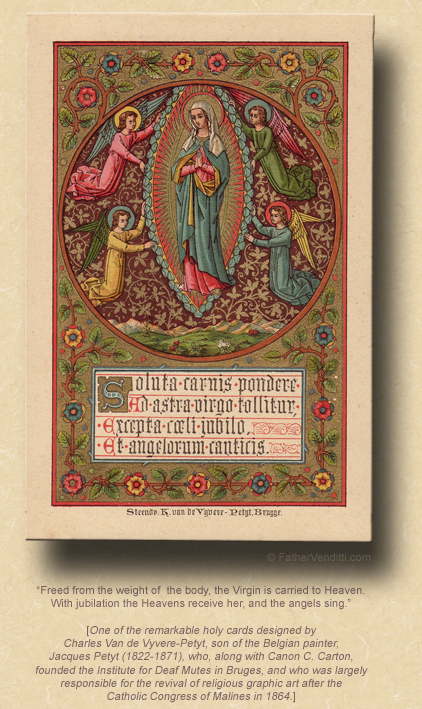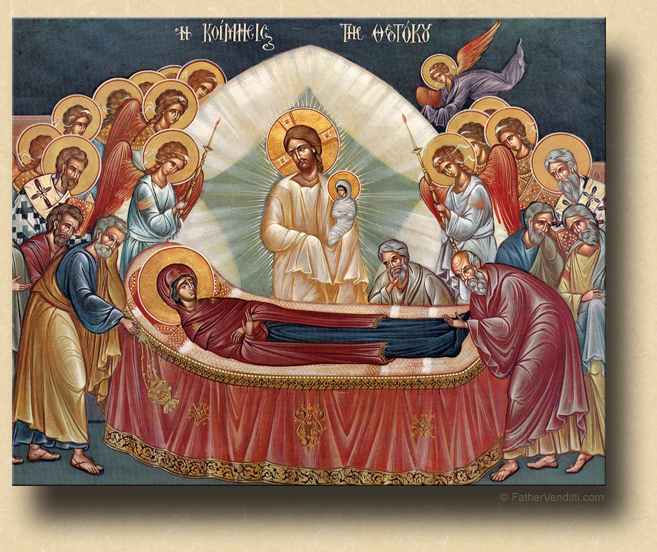"No Man Shall Come to God Except He Be Truly Illumined through Her."
The Solemnity of the Assumption of the Blessed Virgin Mary.
Lessons from the proper, according to the ordinary form of the Roman Rite, for the Vigil:*
• I Chronicles 15: 3-4, 15-16; 16: 1-2.
• Psalm 132: 6-7, 9-10, 13-14.
• I Corinthians 15: 54-57.
• Luke 11: 27-28.
…and for the feast:
• Revelation 11: 19; 12: 1-6, 10.
• Psalm 45: 10-12, 16.
• I Corinthians 15: 20-27.
• Luke 1: 39-56.
The First Class Feast of the Assumption of the Blessed Virgin Mary.
Lessons from the proper, according to the extraordinary form of the Roman Rite:
• Judith 13: 22-25; 15: 10.
• Psalm 44: 11-12, 14.
• Luke 1: 41-50.
The Solemn Holy Day of the Dormition of Our Most Holy Lady, the Theotokos & Ever-Virgin Mary.
Lessons from the menaion, according to the Ruthenian recension of the Byzantine Rite:
• Pillipians 2: 5-11.
• Luke 10: 38-42; 11: 27-28.
FatherVenditti.com
|
 8:55 AM 8/15/2016 — I'm sure you're all aware that the Assumption of the Blessed Virgin Mary is a dogma of faith, defined as such by Pope Venerable Pius XII in 1950, but was something believed for centuries, based on Scripture and explained often by the ancient Fathers of the Church, but without a liturgical celebration to commemorate it, at least not in the West. The Churches of the East were the first to celebrate it with a feast on the liturgical calendar, as early as the fourth century, and called it the Dormition of the Theotokos, or the Falling Asleep of the Mother of God, as they do today. According to their Tradition, after the falling asleep of the Virgin Mother, She was buried, but Her body did not suffer corruption. When the tomb was opened, it was empty, filled with flowers and the fragrance of holiness. But, regardless of whether it's called the Dormition of Mary or the Assumption of Mary, or what traditions surround popular devotion to it, the dogma is the same. 8:55 AM 8/15/2016 — I'm sure you're all aware that the Assumption of the Blessed Virgin Mary is a dogma of faith, defined as such by Pope Venerable Pius XII in 1950, but was something believed for centuries, based on Scripture and explained often by the ancient Fathers of the Church, but without a liturgical celebration to commemorate it, at least not in the West. The Churches of the East were the first to celebrate it with a feast on the liturgical calendar, as early as the fourth century, and called it the Dormition of the Theotokos, or the Falling Asleep of the Mother of God, as they do today. According to their Tradition, after the falling asleep of the Virgin Mother, She was buried, but Her body did not suffer corruption. When the tomb was opened, it was empty, filled with flowers and the fragrance of holiness. But, regardless of whether it's called the Dormition of Mary or the Assumption of Mary, or what traditions surround popular devotion to it, the dogma is the same.
Like everything we believe about the Mother of God, it can only be properly understood in light of Her Son. One of the features of Eastern devotion to Mary is that it always ends up focusing on Christ our God, which is why there are so few icons of the Mother of God which do not contain an image of Christ. Everything that Mary is—every spiritual gift bestowed upon Her by God—is because of the one She was chosen to bring into the world as a man. Take, for example, the fact that Mary was conceived by the just and holy forebears of God, Joachim and Anna, without any trace of the sin with which we are born because of the disobedience of our first parents. We call this gift the Immaculate Conception. This had to be because, in giving physical birth to the Son of God, Mary would be giving Her flesh to our Lord in His incarnation; and, because our Lord is God, that flesh would have to be pure in every way, completely free from the stain of any sin.
And because God alone is Christ’s Father, it would not have been proper for Mary to know any other man, and this She understood; so, She remained a virgin all her life upon earth. The last of the great Fathers of the Eastern Church, Saint John of Damascus, chose to describe the virginal birth of our Lord in a unique way: he said that our Blessed Lord passed through the womb of His Immaculate Mother in much the same way that light passes through a window.
And today’s feast focuses our attention on the final and, perhaps, the greatest gift bestowed upon the Mother of God, that She was spared that inevitable curse of fallen man, the death and decay which normally mark our passing from this world. And the reason for it is really quite simple: because, as the Scriptures teach us, the death of the body is the direct result of our fallen nature; the sin of Adam has corrupted all mankind.  As the book of Genesis tells us, because of this original sin, man will be forced to toil for the bread he eats, women will have pain in childbirth, man will have to struggle against a fallen and corrupted nature in order to avoid sin and temptation, and he will pass from this world only after suffering the trauma of his own death. But Mary was not tainted with this sin by a special act of God, in preparation for being our Lord’s gateway onto earth from heaven. So, how could She suffer the consequences of a fallen nature She did not possess? She is truly, as Saint Gregory Palamas so poetically put it… As the book of Genesis tells us, because of this original sin, man will be forced to toil for the bread he eats, women will have pain in childbirth, man will have to struggle against a fallen and corrupted nature in order to avoid sin and temptation, and he will pass from this world only after suffering the trauma of his own death. But Mary was not tainted with this sin by a special act of God, in preparation for being our Lord’s gateway onto earth from heaven. So, how could She suffer the consequences of a fallen nature She did not possess? She is truly, as Saint Gregory Palamas so poetically put it…
“…the receptacle of great graces. …She only is the frontier between created and uncreated nature, and there is no man that shall come to God except he be truly illumined through Her.”
And it was this consideration that led the early Church Fathers to recognize the spiritual significance of the Mother of God, and the place She held in the relationship between God and man.
That phrase by Saint Gregory Palamas, by the way, is a very simple statement of a very profound truth: “…no man shall come to God except he be truly illumined through Her.” It means that the role of the Mother of God, as the “frontier” between heaven and earth, did not end in the incarnation of our Lord. Mary was the doorway through which God came to earth, but the door was never closed; and She remains, through all eternity, the doorway through which we can go to God. How can we possibly love our Lord without honoring His holy Mother? To attempt to do so would be to deny Christ His divinity. How can we love Mary without worshiping the Son she bore, and living His Gospel to completeness? To do so would be to insult the person we hope to honor by ignoring Her very purpose.
Now, I did say that, while the Churches of East and West give different names to this feast, the dogma the feast celebrates is the same, and that's true; but, the traditional Byzantine icon of the Dormition is strikingly different from the images of the Assumption with which we are familiar, which usually show the Mother of God Ascending into heaven, or being crowned by Christ as Queen of heaven and earth. The icon of the Dormition, by contrast, depicts the Mother of God upon the bed of death, surrounded by our Lord’s Apostles, not clothed in the dark garb of mourning, but in the brightly colored garb of celebration, because even they understand that, in this case, death is not really death. And standing over the bed, in the center—where he always belongs—is Christ, surrounded by a choir of angels because He is looking down from Heaven. And in His arms we see what appears to be a small child dressed in white, which is actually the pure and sinless soul of His Mother, which he receives and translates into heaven, with the understanding that Her body would follow. And the celebration of Vespers in the Byzantine Rite for this feast contains a beautiful hymn which reads:

O marvelous wonder! The source of life is laid in the tomb, and the tomb itself becomes a ladder to heaven. Glorious are Your mysteries, O pure Lady. You were made the Throne of the Most High, and today You are translated from earth to heaven. Let us praise the most holy Translation of the Mother of God: for She has delivered Her spotless soul into the hands of Her Son.
Let us, who worship Her Son, honor Her in the only way that matters: by avoiding those sins from which Her Son suffered and died to save us, and by living faithfully and always the Gospel that He came to teach us.

* Cf. the note attached to yesterday's post regarding the observance of the vigil of this solemnity.
|

